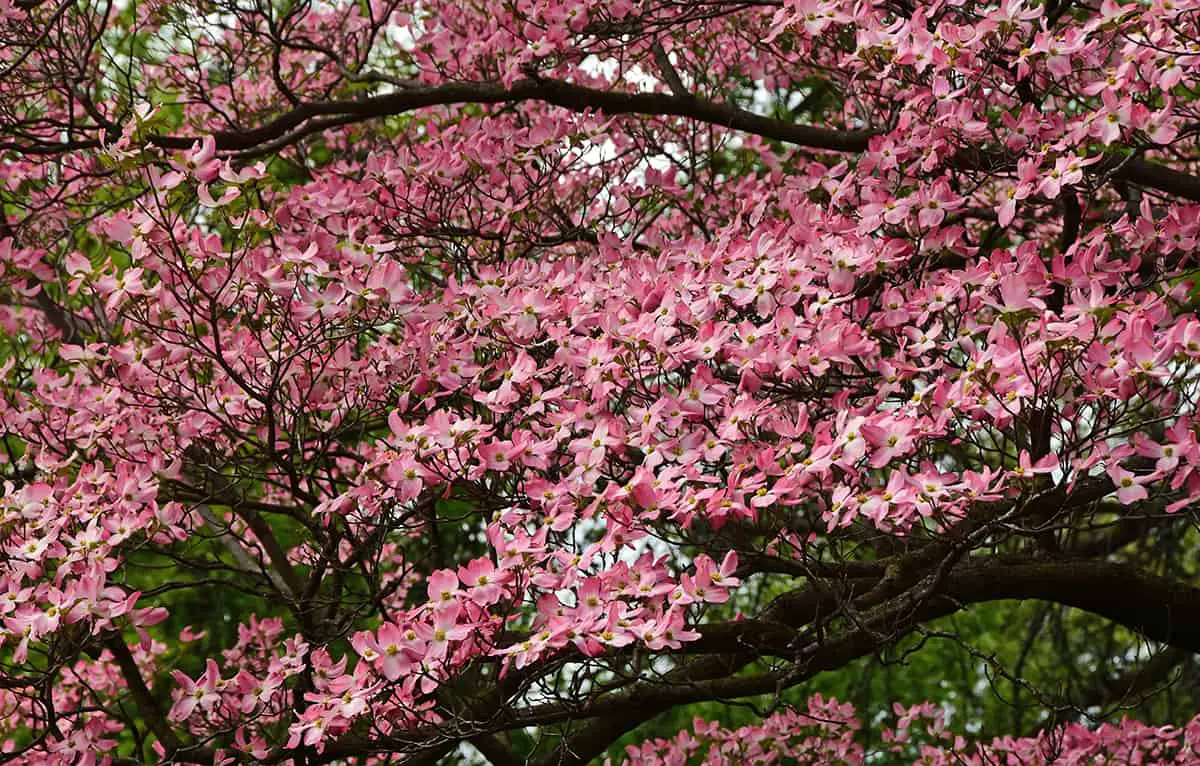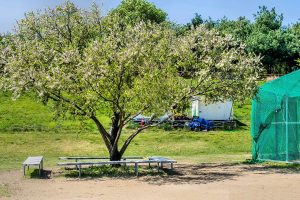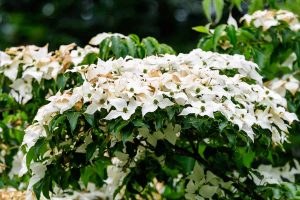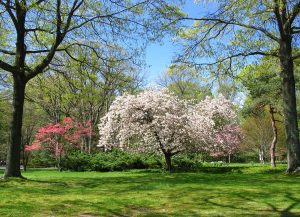The Pink Dogwood tree is widely regarded as one of the most decorative types of deciduous trees amongst gardeners, thanks to its continual interest throughout all four seasons. Here we explore the best ways to care for a Pink Dogwood tree, along with other varieties of Pink Dogwood.
- Botanical name: Cornus florida f. rubra
- Common names: Pink Dogwood, Pink Flowering Dogwood, Flowering Dogwood, Eastern Flowering Dogwood, North American Green Osier
- Plant family: Cornaceae
- USDA hardiness zone: 5 – 9
- Mature height: 15 to 30 feet
- Mature spread: 15 to 30 feet
Table of Contents
What is a Pink Dogwood Tree?
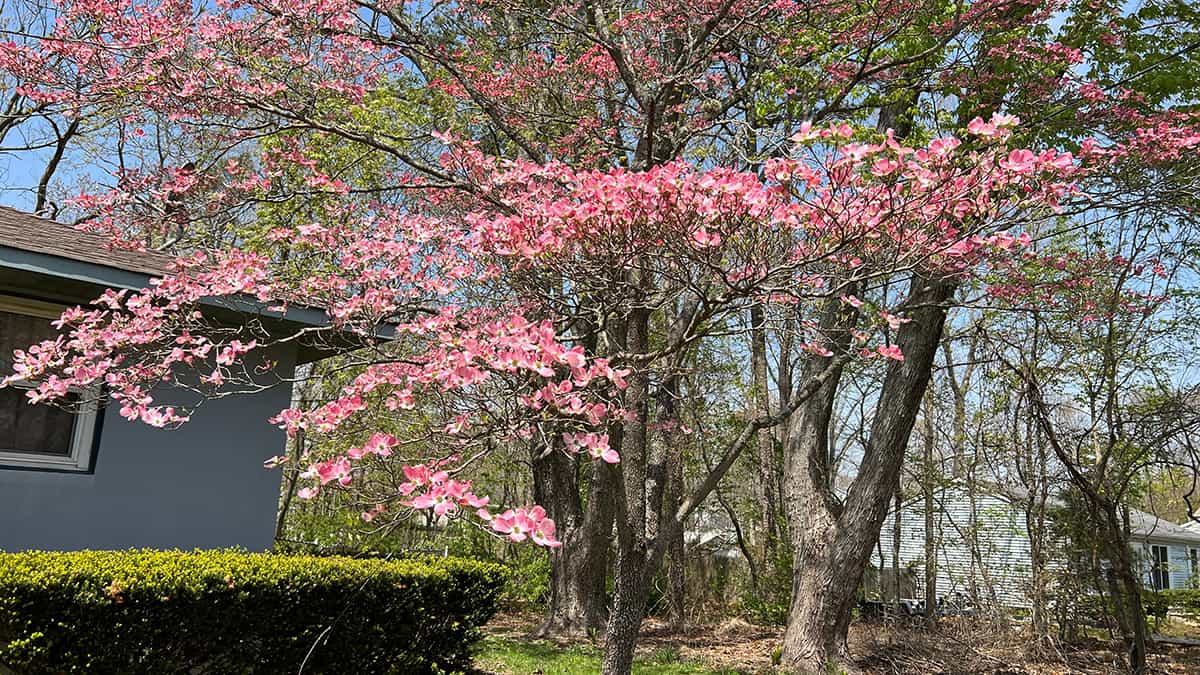
The Pink Dogwood tree is a small, deciduous tree native to North America. It is fast growing, gaining around one foot in height per year to a mature height of between 15 and 30 feet with a similar-sized spread. It has a broadly conical-shaped canopy, which displays bright pink blooms in the early spring of each year.
The flowers usually arrive before the leaves have emerged and will last for 2 to 3 weeks. These vivid blooms are actually made up of showy pink-red leaf bracts, which are easily mistaken for petals, and the true flowers are tiny clusters of green that sit at the center of the leaf bracts. These flowers progress into brightly colored orange or red berries in the summer, which are famous for attracting butterflies.
They can remain on the tree right through fall and into winter unless eaten by hungry birds. Throughout summer, the Pink Dogwood tree offers wonderful shade thanks to its densely layered canopy of bright green leaves. In fall, the leaves take on shades of red, burgundy, and purple, for a spectacular display of autumnal color. After all of the leaves have been shed, the bare skeleton of the tree maintains interest through the winter months with its alligator-patterned bark.
Origins of the Pink Dogwood Tree
The Pink Dogwood tree was first recorded by Marc Catesby, a plant hunter, in 1731. Since then, it has been widely cultivated as an ornamental specimen and remains a favorite amongst gardeners.
It grows natively in eastern Mexico, through the eastern United States, and into Southeastern Canada. The Pink Dogwood flower is the state flower of North Carolina, where it grows as an understorey tree in abundance.
Types of Pink Dogwood Tree
Cherokee Sunset
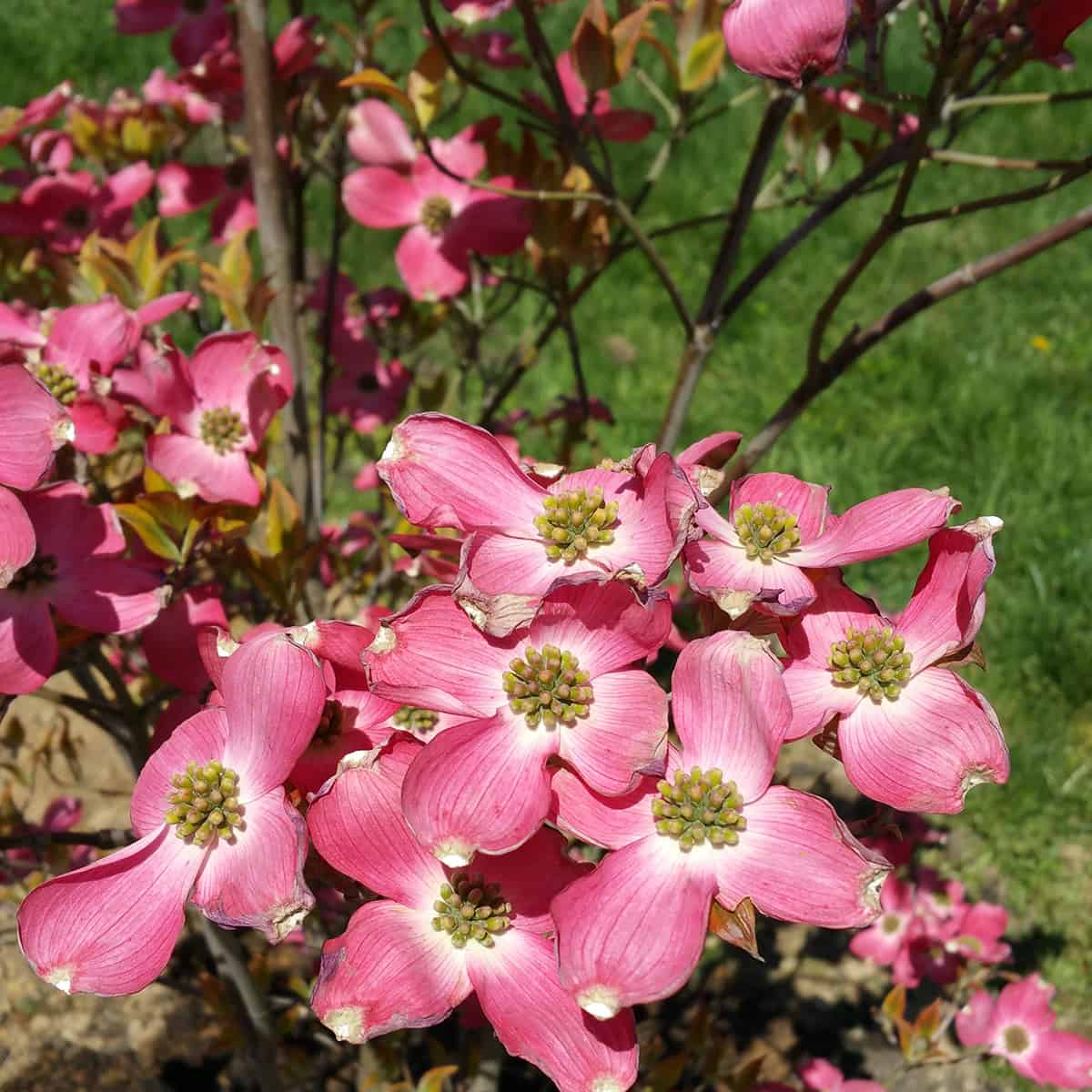
This variety of Pink Dogwood can be grown as a large shrub or a small tree, typically reaching between 20 and 25 feet tall at maturity. The blooms are composed of colorful leaf bracts, which are white at the middle, fading out to pink at the tips, and surrounding the tiny cluster of central green flowers.
These emerge on the tree in April or May before the arrival of the foliage. They develop into bright scarlet-colored berries, which hold interest right into fall. The leaves of this tree are very ornamental, in variegated lime green and medium green through summer. In fall, the foliage descends into a vivid display of pink, purple, and red. The Cherokee Sunset variety of Pink Dogwood has a rounded habit and is resistant to deer.
Cherokee Chief
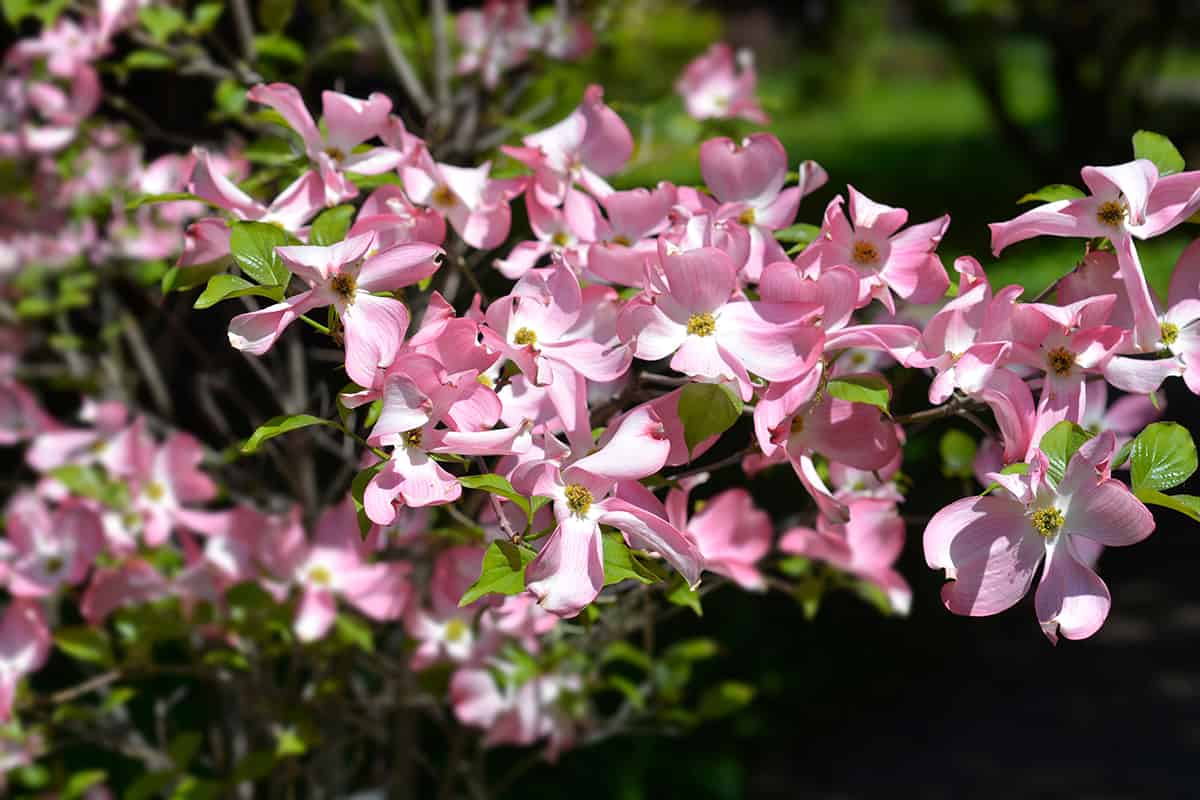
Cherokee Chief is known as one of the best and most popular types of dark pink dogwood. It produces star-shaped blooms that measure around 4 inches across, with leaf bracts in a dark shade of pink-red.
These develop into bright red berries in summer and persist through to fall. The Cherokee Chief takes the shape of a rounded large shrub or small tree, reaching a maximum height of 25 feet with a spread of between 12 and 18 feet.
Cherokee Brave
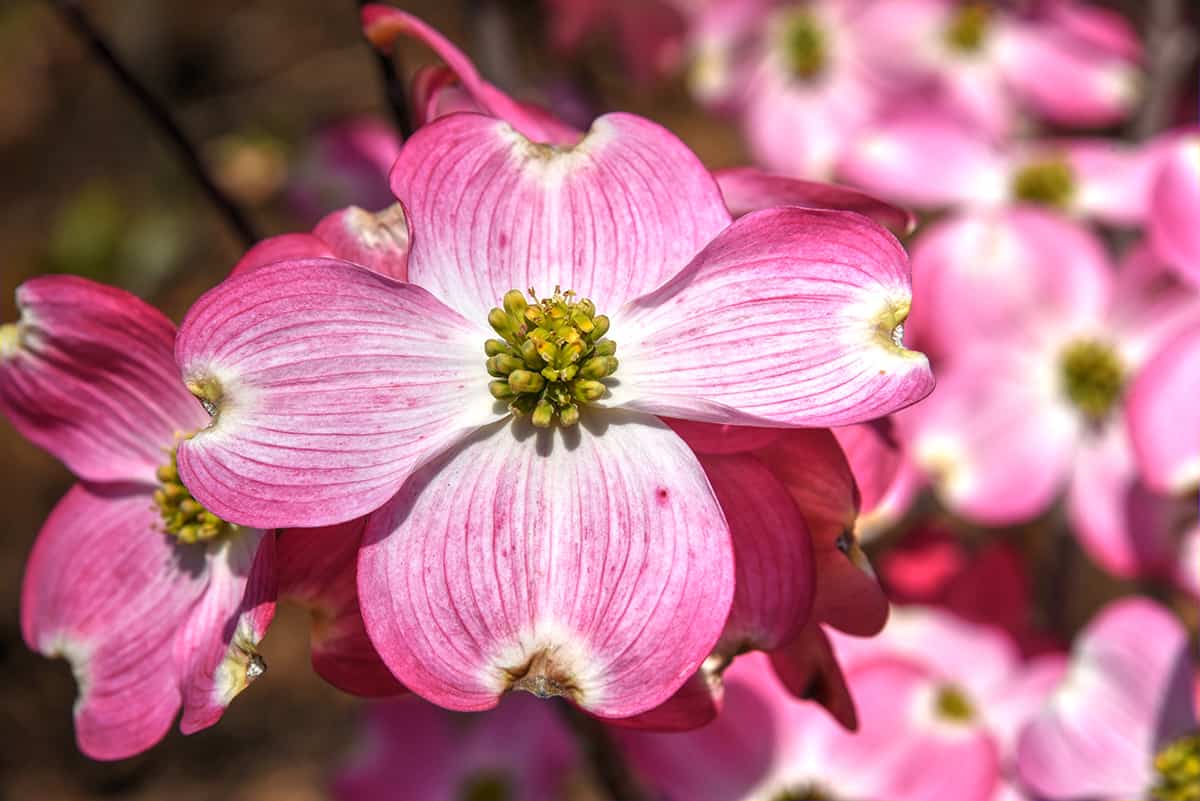
This Pink Dogwood can be grown as a large shrub or small tree, typically reaching between 25 and 30 feet tall. It has a rounded canopy, with layered branches that extend horizontally. The flowers of the Cherokee Brave dogwood variety are deep pink with a flush of white in the middle.
They develop into scarlet red fruits that are popularly devoured by birds. The leaves of this tree are mid-green through summer, fading to bronze-red in the fall before dropping from the tree. The bark is pale gray and smooth when the tree is young, taking on a scaly alligator-skin pattern on more established specimens.
How to Care for Pink Dogwood Trees

- Light: Partial shade
- Soil: Well-draining, acidic
- Water: Average moisture
- Hardiness: USDA zones 5 – 9
Light
Pink Dogwood trees thrive in partial sun and partial shade. In their natural environment, they are understory trees that are shaded by the canopy of taller trees, enjoying dappled light. They can grow in full sun in slightly cooler climates, but these trees will tend to be much more dense and need to be thinned out to prevent disease.
Soil
These trees thrive in any well-draining soil which is kept evenly moist. They aren’t fussy about soil types but prefer soils that are fertile, and either acidic or of neutral pH. Pink Dogwood trees perform best when their root systems are cool, so it is beneficial to mulch over the soil in summer.
Water
Pink Dogwood trees need consistently moist, but not wet, soil. They are not drought tolerant, so you should not allow their soil to dry out. Water generously through summer and ensure there is good drainage so that the soil does not become waterlogged from excess water.
Temperature
Pink Dogwoods are suitable for growing in USDA hardiness zones 5 – 9. They prefer temperatures that that are neither too cold nor too hot. In warmer climates, they should be planted in sheltered positions to avoid too much direct sun, and soil should be mulched to keep the roots of the tree cool.
Humidity
Humidity is not a requirement for Pink Dogwood trees, but it can be beneficial. These trees do not grow well in dry climates, so moist climates will provide a more suitable growing condition.
Fertilizer
Fertile soil will not need any additional fertilizer for Pink Dogwood trees, however, if your soil is poor then fertilizer will be essential. You can also amend the soil to improve its nutrient content, for example by working organic compost into the top few inches of the soil periodically throughout the year. If you use a fertilizer, opt for a slow-release all-purpose fertilizer and be sure to apply to the soil around the base of the tree, avoiding contact with the trunk.
Pests and Diseases
Fortunately, Pink Dogwood trees are mostly pest-free, though they can be attacked by oyster shell scale, calico scale, Japanese maple scale, dogwood borer, dogwood sawfly, and leafhoppers. Disease is the primary issue amongst these types of trees, with spot anthracnose being the main culprit. Dogwood trees have a reputation for falling victim to dogwood anthracnose/Cornus anthracnose, however, this is actually very uncommon in lower elevations.
It will usually only affect trees at 1800 feet elevation or higher. Other diseases which can be problematic for Pink Dogwoods are powdery mildew, leaf spot, canker, bacterial leaf scorch, and septoria leaf spot. As Pink Dogwoods thrive in moist environments, they are more likely to suffer from fungal diseases, as fungal spores also thrive in moisture.
To help reduce the chance of fungal disease, thin out the canopy of your Dogwood annually to improve air circulation around the leaves, and always irrigate at soil level to avoid the leaves from becoming unnecessarily wet.
Pink Dogwood Tree FAQs
How Far Apart Should Pink Dogwood Trees Be Spaced?
Pink Dogwood trees typically grow between 15 and 30 feet wide and, therefore should be spaced at around 10 to 15 feet apart. They can be planted beneath taller trees with sparse canopies, as they will not extend beyond 30 feet tall.
Can Pink Dogwood Trees be Propagated?
Pink Dogwood trees can be propagated from cuttings. This is best done in June to increase the chances of success. You will need a cutting of around 6 inches, taken from new wood on the tree. This can be identified by a branch that is easily flexible and does not snap when bent. The cutting should have a few new leaf shoots at one end, and any lower leaves will need to be removed.
It should be cut at a 45-degree angle, around one inch from a leaf node. Insert the cut end of the branch into a pot of moist soil mix, ensuring good drainage, with the leaf node buried in the soil. Mist the cutting with water and place the pot with the cutting in a greenhouse, inside a plastic dome, or in a sealed clear plastic bag.
This will create a humid environment to help the cutting root. It should then be positioned in a very bright spot, such as a south-facing windowsill or beneath a grow light. After five weeks, the cutting should have taken root. You can check this by gently tugging at the cutting to feel for resistance.
Once the cutting has rooted, it can be acclimated to regular humidity by taking it out of a greenhouse for an hour a day, gradually increasing this timeframe. Once fully adapted, it can be planted outside in the ground or moved to a larger, more permanent pot.
